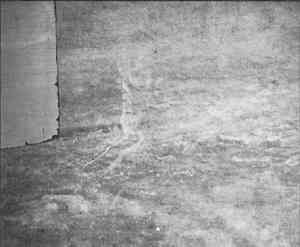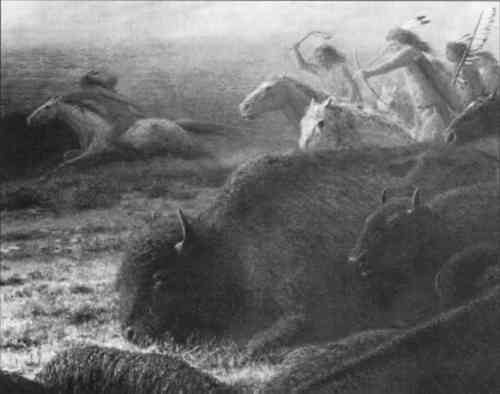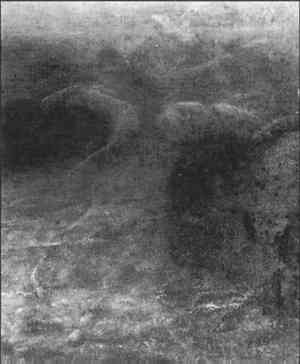CORCORAN AND CODY: THE TWO VERSIONS OF THE LAST OF THE BUFFALO
DARE MYERS HARTWELL, & HELEN MAR PARKIN
3 RELATIONSHIP OF THE TWO PAINTINGS
There are numerous studies for individual elements in the composition of The Last of the Buffalo. However, no sketch for the entire painting exists, and it is apparent that the overall composition was still being worked out by Bierstadt as he painted. Many changes in location and scale of figures can be found in the middle ground of both paintings, and, in fact, certain areas appear to contain the same design change. Some of these changes are visible on the surface of the painting as pentimenti, while others are revealed by x-radiographs or examination with the infrared Vidicon camera. For example, a pentimento of an antelope is visible in both paintings immediately to the right of the standing buffalo at left (figs. 5, 6). At the right between the rearing horse and the buffalo herd, both paintings have a pentimento of a large mounted figure drawing back a bow (figs. 7–10). It should be noted that the scale of these pentimenti differs from that of the surrounding figures, indicating that Bierstadt was moving compositional elements back and forth in space in an effort to create a satisfactory recession from foreground to background.
Fig. 5.
Bierstadt, The Last of the Buffalo, Corcoran Gallery version, detail of an infrared reflectogram of a pentimento of an antelope. Photograph by Dare Myers Hartwell
 |
Fig. 6.
Bierstadt, The Last of the Buffalo, Buffalo Bill Historical Center version, x-radiograph of a pentimento of an antelope. Courtesy of Perry C. Huston and Associates, Center for the Conservation of Art, and the Buffalo Bill Historical Center
 |
Fig. 7.
Bierstadt, The Last of the Buffalo, Corcoran Gallery version, detail showing a pentimento of a large mounted figure drawing back on a bow in the area of the lead running horse. Photograph by Dare Myers Hartwell
 |
Fig. 8.
Bierstadt, The Last of the Buffalo, Corcoran Gallery version, infrared reflectogram of the pentimento shown in fig. 7. Photograph by Dare Myers Hartwell
 |
Fig. 9.
Bierstadt, The Last of the Buffalo, Buffalo Bill Historical Center version, detail showing a pentimento of a large mounted figure drawing back on a bow. Courtesy of Perry C. Huston and Associates, Center for the Conservation of Art, and the Buffalo Bill Historical Center
 |
Fig. 10.
Bierstadt, The Last of the Buffalo, Buffalo Bill Historical Center version, x-radiograph of the pentimento shown in fig. 9. Courtesy of Perry C. Huston and Associates, Center for the Conservation of Art, and the Buffalo Bill Historical Center
 |
Compositional sketches are rarely found for Bierstadt's large studio paintings, and design changes, particularly in the middle ground, are not uncommon. However, the number and scale of the changes in The Last of the Buffalo seem to indicate that Bierstadt had more than the usual difficulty working out the composition in both paintings. Furthermore, the presence of similar design changes in two large versions of a painting may be unprecedented. It eliminates the possibility that one painting is a copy of the other and leaves the relationship between the two paintings puzzling.
In an unidentified and undated newspaper clipping titled “No Place for Bierstadt—The Last of the Buffalo' excluded from the Paris Exposition,” Bierstadt is quoted as saying, “That is the study (pointing to a huge painting) for the picture now in the Salon” (Bierstadt scrapbook). Because the Corcoran version is unquestionably the one sent to the Salon, it seems likely that the artist was referring to the Cody picture. If one trusts the accuracy of this account, the Cody picture must be the preliminary version. However, we know that Bierstadt did not normally paint studies for entire compositions and certainly not on this scale. Furthermore, the numerous changes in scale and location of figures in both paintings indicate that Bierstadt was not able to solve the problem of spatial relationships in the “study.” Although we cannot be certain without further documentary evidence, it seems likely that, in order to deal with these spatial problems, at some point in the painting process the artist decided to switch from the Cody picture to the larger format of the Corcoran picture, in which the space is much more successfully realized. Bierstadt could have transferred the design of the “study” to the larger canvas and then refined it. If he then returned to the Cody picture and completed it, as seems likely, it would have been at this point that he painted out such details as the antelope and the additional mounted figure. He also apparently decided to abandon the graphite ground entirely for the Corcoran painting, which may account for the fact that it is in better condition.
|





